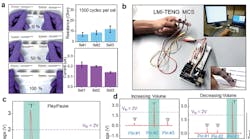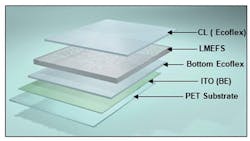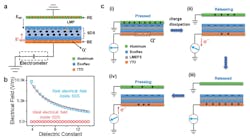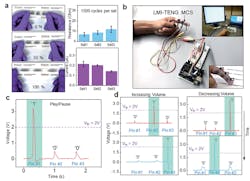Liquid-Metal Triboelectric Nanogenerator Harvests Body Motion
>> Website Resources
.. >> Library: TechXchange
.. .. >> TechXchange: Power Management
.. .. .. >> Topic: Energy Harvesting
There’s apparently little limit to the imaginative ways that researchers are seeking to harvest “free” energy, whether it’s conveniently available (such as running water) or somewhat accessible with some effort (small amounts of body motion). A team at Purdue University led Prof. Wenzhuo Wu, the Ravi and Eleanor Talwar Rising Star Assistant Professor of Industrial Engineering, has developed a multilayer transducer using liquid in a matrix at its core—it functions as a nanogenerator by triboelectrification and electrostatic induction. They also demonstrated the effectiveness of their approach even with low-frequency motion.
Their liquid-metal-inclusion-based triboelectric nanogenerator (LMI-TENG) structure has a layer of liquid metal embedded functional silicone (LMEFS) sandwiched within two Ecoflex layers (Fig. 1), each layer has a thickness of about 100 µm. (Ecoflex is a very stretchy, very strong, low viscosity, soft silicon rubber; it can be stretched to many times its original size without tearing and will rebound fully.)
1. This 3D schematic shows the LMI-TENG's layered structure and constituent materials. (Source: Purdue University)
The LMI-TENG has an indium-tin-oxide (ITO) back electrode (BE) and a grounded aluminum reference electrode (RE). The LMEFS layer was prepared by using a mechanical stirring process to yield different ratios of galinstan (a eutectic alloy with a composition ratio of 68.5% gallium, 21.5% indium, and 10% tin by weight) as liquid metal particles (LMPs) with the Ecoflex silicone.
Voltage and current tests for the resultant configuration were performed at different concentrations of the liquid metal particles (LMPs) (Fig. 2), as well as variations in particle size and shape. They also developed several ideal atomic- and electric-field models for simulation and analysis, then modified these extensively to accommodate the reality that the LMI-TENG structure has finite dimensions.
2. Shown is the electrical characterization of the LMI-TENG, with (i) the comparison between 0% and 50% (by weight) of LMI-TENGs' open-circuit voltage; (ii) short-circuit current density; and (iii) short-circuit transferred charge density. (Source: Purdue University)
This led to an adjustment in their understanding of the actual energy-capture mechanism (Fig. 3). Additional optical and atomic microscope tests were used to examine the material at various levels of detail and from different perspectives.
3. LMI-TENG’s electrostatic interaction was observed, considering the effect of surface leakage charges: Schematic illustration of the electrostatic induction and charge distribution within the sandwiched dielectric stacks (SDS) and BE (a); Finite-element-analysis (FEA) result of the electrical field as a function of the dielectric constant in the SDS (b); illustration of the modified TENG working mechanism for the LMI-TENG (c). (Source: Purdue University)
While these models and analysis plus the associated tests are important, they lack drama and flair, so the team devised a tangible demonstration. They also wanted to showcase the ability of their stretchable LMI-TENG harvester to operate efficiently at low frequencies (<1 Hz), a consideration that’s important for human-integrated applications as well as harvesting from larger-scale mechanical energy sources such as ocean waves.
To do this, they built a stretchable, wireless media control system (MCS) (Fig. 4), with three distinct LMI-TENG units, connected to a 10-bit data acquisition system. The device can adhere to the human skin comfortably without use of tape. The signals from this system were detected, with encoding of the different finger motions into electrical signals having distinct patterns then used for wireless control of a music player on a remote computer.
4. Here, LMI-TENG is tested for a self-powered user-interface application: testing the ability of LMI-TENG to stretch, with an Ag NW electrode (a); photo of the wearable LMI-TENG MSC—the inset shows the testing system and a wearable LMI-TENG MSC device (b); the status signals corresponding to different user-interface functions that were achieved by the media control system (c and d). (Source: Purdue University)
Full details are in their paper “Wearable high-dielectric-constant polymer with core-shell liquid metal inclusions for biomechanical energy harvesting and self-powered user interface” which appeared in The Journal of Materials Chemistry A (an unlocked version is available here). There’s also additional Supplementary Information and an available short video here.
>> Website Resources
.. >> Library: TechXchange
.. .. >> TechXchange: Power Management
.. .. .. >> Topic: Energy Harvesting





